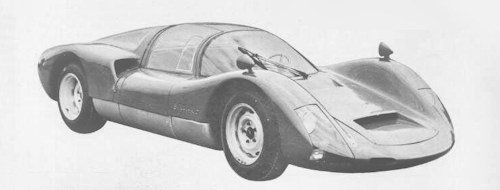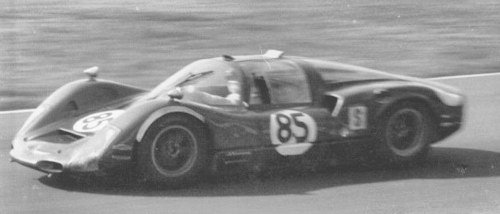Porsche 906
 | |
Production period: | 1965 to 1966 |
Class : | race car |
Body versions : | Coupe , Roadster |
Engines: | Gasoline : 2.0-2.2 liters (155-198 kW) |
Length: | 3580-4600 mm |
Width: | 1680 mm |
Height: | 980 mm |
Wheelbase : | 2300 mm |
Curb weight : | 488-710 kg |
The Porsche 906 , officially marketed as Carrera 6 , was a race car of Porsche KG in the 1960s .
History
The Porsche 906 coupe was a development on the basis of the 1965 European Hillclimb Championship and successor of the Porsche 904 .
In 1966, the factory team used the 906 in the sports car world championship and in the European mountain championship, which Gerhard Mitter won with the car. In the World Cup brand Porsche won in the 2-liter and 2-liter prototype sports car class.From 1967 to 1971 only private teams drove the Porsche 906 in the sports car world championship, European mountain championship and national championships.
Like the 904, the Porsche 906 was to receive homologation for the sports car class of the sports car world championship. Therefore, according to FIA regulations at least 50 vehicles of the type had to be sold. The 906 was sold as Carrera 6 , because Peugeot had three-digit numbers with a zero in the middle as names for road vehicles to protect. Due to the high demand, 15 more cars were produced after the planned 50 vehicles.
The 906 Bergspyder from 1965-1966 was the successor of the 904 Bergspyder, which was also called "kangaroo" because of its handling. Instead of a steel box frame , the 906 had a lighter grid frame , over which a lightweight aerodynamic plastic skin was mounted. The chassis had the number 906 010.First used was the Spyder with this body in 1965 at the hill race Ollon-Villars. The following year, the developers built around the race car coupe. The coupe already had the basic design elements such as the gullwing doors and the plexiglass hood over the engine of the later Series 906. The empty weight of lightweight race car was finally 488 kg.
In order to finish the Bergspyder in the 1965 season, Porsche acquired a complete Formula One chassis from Lotus in England.This included the wheel carrier and 13-inch light alloy wheels with central locking device , the original still from 904 Bergspyder derived 15-inch steel wheels with tires in the dimensions 5.50 / 15.00-15 front, and 6.00 / 15.00- Replaced 15 behind.
From its predecessor, the air-cooled 2-liter eight-cylinder boxer engine Type 771 was used. Mixture preparation took place via a Bosch injection system. Two crankshafts per row of cylinders driven by a vertical shaft controlled the valves. The engine delivered at a compression ratio of 10.5: 1 up to 191 kW (260 hp) at 8800 rpmWith the 906 five-speed manual transmission, the car reached a top speed of about 260 km h.
The 906 Coupe was developed on the basis of the 906 Bergspyder. The steel-tube frame was not only supporting element, but served also as an oil pipeline system. In some pipes, the engine oil was routed from the engine to the oil cooler and back again to save weight, which would have caused additional lines. Over the space frame was mounted an aerodynamically designed plastic body. The only 980 mm high coupe had a far down and forward drawn front, in which the headlights and indicators were recessed behind a transparent plastic disc. On some models, the front left and right were small spoiler mounted to press the vehicle by inflowing air closer to the ground.
The tubular frame required upwardly opening double doors to enter the two-seated carriages. The engine was as mid-engine immediately behind the cockpit and was covered by a transparent yellow, louvered Plexiglas the flush dropped from the roof edge to the rear. The rear ended in a so-called K-shape and could be folded completely back to get to the engine and the transmission. For racetracks that had long straights and high speeds, the developers designed a long-tail version. These vehicles achieved higher top speeds through improved aerodynamics over the standard coupe. The long-tail version had except the extended tail extended and slightly deeper pulled down front. The Group 4 racing car had an empty weight of 675 kg for the standard version and a slightly higher weight of 710 kg for the long-tail version.
The chassis was taken over large parts of the Porsche 904/6: independent suspension with inclined wishbones and longitudinal struts front and rear coil springs and telescopic shock absorbers. The front 16 mm strong and 15 mm rear stabilizer reduced the inclinations of the vehicle in curves. In order to further improve the driving behavior of the suspension arms and stabilizers in metal were supported instead of rubber. For cost reasons, the developers used the dual-circuit brake system and the tires of the 904/6. By separately addressed in a front and rear brake disc brakes, a complete failure of the brakes is avoided, enabling an adjustment of the braking action on the track needs. The 15 inch five hole steel wheels were relatively heavy and had the front 7J × 15 size with 5.50 / 15.00-15 race tires and rear 9J × 15 with 6.00 / 15.00-15 race tires. The prototype versions used by Porsche included some improvements in chassis and weight compared to the standard 906 purchased from customers. So some chassis parts were used as the steering knuckles made of lightweight titanium instead of steel. The brake discs were in some racing cars from the very light beryllium and reduced the curb weight compared to cast iron brake discs by a few kilograms.
The homologated model air-cooled 2-liter six-cylinder boxer engine type 901/20 was an evolution of the Porsche 911 engine and was already used in the 904/6 in racing. The crankcase was made of light electron produced. Further weight was saved by using titanium connecting rods instead of steel. The flywheel weighed 3.5 kg and was about 2.5 kg lighter than the standard disc.As with the production engine, the cylinder heads were made of aluminum alloy, but had been further revised for racing use. The inlet and outlet valves were sodium-cooled and larger in size. For the double ignition system, the cylinder heads received another version for the second spark plug per cylinder. The two camshafts had different timing than the production model, and were driven by a chain. Overall, the racing engine was 54 kg lighter than the 911 series engine.
For mixture preparation, Porsche used a triple downdraft carburetor from Weber for each cylinder series. At a compression of 10.3: 1, the engine produced around 155 kW (210 hp) at 8000 rpm. Equipped with this engine, 52 cars were produced. Nine working vehicles received the 2-liter six-cylinder engine with an injection system, could be increased so that the engine power with unchanged speed by 7 kW (10 hp) to 162 kW (220 hp).
Another four factory 906 received an air-cooled eight-cylinder boxer engine of the type 771, which was already used in the 904/8. The engine had a displacement of 2.2 liters with a compression ratio of 10.2: 1 and main shafts, which drives the two overhead camshafts per cylinder bank. The maximum power was 198 kW (270 hp) at 8600 rpm. All vehicles were equipped with a type 906 five-speed gearbox and ZF limited slip differential . The gear ratios could be replaced as needed without removing the gearbox.
Race History
The Series 906 started for the first time at the 24 Hours of Daytona . That of Hans Herrmann and Herbert Linge driven car finished sixth in the overall standings and won in the 2-liter prototype class, were there at the time not yet the necessary 50 vehicles for the homologation of the sports car class completed ,
At the Sebring 12 Hours , the 906 ended the race in fourth place and won the class victory over Ferrari's direct competitor Dino 206S , which finished fifth. In the following 1,000-km race at Monza could repeat the result Gerhard Mitter and Hans Herrmann and in fourth place overall.
For the first time at the 24 Hours of Le Mans , the Porsche factory team used three long-tail versions of the 906 alongside two series 906s. The long-tailed cars finished behind four Ford GT40 ranks four to six in the overall standings. A Series 906 finished in seventh place and completed the success of the 2-liter racing cars.
At the Mugello Grand Prix , the Porsche 906 driven by Gerhard Koch and Jochen Neerpasch won the race ahead of three Alfa Romeo GTA . Another victory won Porsche at the Grand Prix of Hockenheim . There, in addition to various private 906 also launched three factory 906. Porsche used the race to test improvements to the fuel injection vehicles. The works cars driven by Gerhard Mitter, Günter Klass and Hans Herrmann finished the race in positions one to three. Behind in the fourth to sixth lead three privately used 906.
The Porsche factory team put the 906 next to the 910 in the 1967 World Sports Car Championship only in the races in Sebring, Monza and Le Mans. When 24-hour race at Le Mans reached Vic Elford and Ben Pon seventh place overall and S2.0-class victory behind a Porsche 907 and 910.

Rating
Technical
-
Porsche 906 Technical data (1965-1966)
Porsche 906:
906 Coupé
(homologation model)906 coupe
906 long tail coupe
906/8 coupe
906/8 Bergspyder
"Ollon Villars"Engine:
6-cylinder boxer engine (four-stroke)
8-cylinder boxer engine (four-stroke)
displacement:
1991 cm³
2195 cc
1981 cm³
Bore × stroke:
80.0 × 66.0 mm
80.0 × 54.6 mm
76.0 × 54.6 mm
Power at 1 / min:
155 kW (210 hp) at 8000
162 kW (220 hp) at 8000
198 kW (270 hp) at 8600
191 kW (260 hp) at 8800
Max. Torque at 1 / min:
196 Nm at 6000
206 Nm at 6400
230 Nm at 7000
210 Nm at 7100
Compression:
10.3: 1
10.2: 1
10.5: 1
Valve control:
one overhead camshaft , chain control
two overhead camshafts each, vertical shaft control
Cooling:
Air cooling (blower)
Transmission:
5-speed gearbox and limited slip differential; rear-wheel drive
brakes:
Dual-circuit disc brakes
Front suspension:
Double wishbone with stabilizer
Rear suspension:
obliquely mounted wishbones with stabilizer and guide by longitudinal struts
Front suspension:
Coil springs with telescopic shock absorbers
Rear suspension:
Coil springs with telescopic shock absorbers
Body:
Plastic body with tubular frame
Track front / rear:
1338/1402 mm
1340/1410 mm
Wheelbase :
2300 mm
Tires rim:
VA: 5.50 / 15.00-15 to 7J × 15
HA: 6.00 / 15.00-15 to 9J × 15VA: 5.25-13 to? J × 13
HA: 7.00-13 to? J × 13Dimensions L × W × H:
4113 × 1680 × 980 mm
4600 × 1680 × 980 mm
4113 × 1680 × 980 mm
3580 ×? ×? mm
Curb weight :
675 kg
710 kg
488 kg
maximum speed:
260 km / h
280 km / h
260 km / h
The carbureted six-cylinder engines had 155 kW (210 hp) slightly less power than the six-cylinder injection engines that delivered 162 kW (220 hp).




